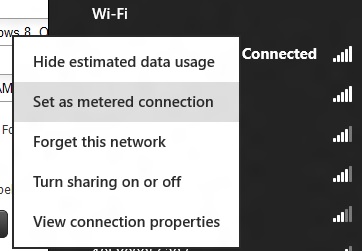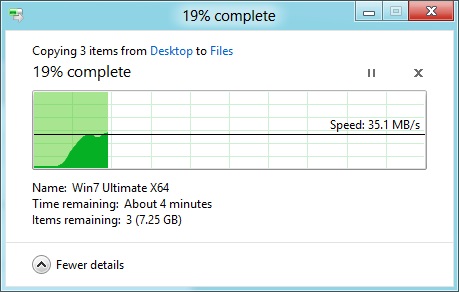In-Depth with the Windows 8 Consumer Preview
by Andrew Cunningham, Ryan Smith, Kristian Vättö & Jarred Walton on March 9, 2012 10:30 AM EST- Posted in
- Microsoft
- Operating Systems
- Windows
- Windows 8
Networking improvements
The widespread adoption of cellular connectivity in an increasing number of laptops and tablets have made our computing devices more mobile than ever before, but it has also given rise to an age of data caps, bandwidth throttling, and exorbitant prices from carriers. In the United States, unlimited data plans are a thing of the past, and as such any operating system worth its salt is going to have to be more careful about what, where, when, and how it sends and receives data.
To that end, Microsoft has instituted several features in Windows 8 that both users and developers can utilize to measure data usage and keep it in check.

Thanks to class drivers (which we'll discuss in just a minute), mobile broadband chips are treated as first-class devices in Windows 8—the same as wi-fi, ethernet, Bluetooth, and USB 3.0, among others—which means that broadband adapters can be turned on and off through the Windows GUI in the same way that wi-fi and Bluetooth now are, and there's also an Airplane Mode can turn all of it off in one swoop, just like on a smartphone (see above). As on phones, Windows will automatically prioritize wi-fi networks when both wi-fi and cellular are available.
This increased integration into Windows has many benefits: if your laptop or tablet has a SIM card installed, Windows can automatically detect which carrier it's associated with and download any available mobile broadband app from the Windows store, and carrier-unlocked laptops and tablets can choose between multiple cellular carriers if the hardware supports it. Windows also offers estimated data usage figures when connected to cellular networks, and when connected to a cellular network the OS will adjust its default behaviors to conserve bandwidth (for example, deferring the automatic downloading and installation of Windows updates until wi-fi is available).

Though it is off by default, these bandwidth conservation features can also be enabled for traditional wired and wireless network connections by right-clicking the name of the network you're connected to. While on a metered network, apps can now use new APIs to force network-aware Metro apps to use less data when possible (another example: using a low-bandwidth movie stream rather than a high bandwidth one). Network-aware Metro apps are required to use these APIs, and users can check how much bandwidth apps are using (both on metered and non-metered networks) in the new Task Manager.
Improvements to networking in Windows also extend to file copying, namely the SMB networked file sharing protocol. In Windows 8, the protocol can now shift dynamically between different network adapters during copy operations so that it always uses the fastest possible connection to transfer files. To demonstrate, I began copying a few gigabytes of data to a fileserver on my home network using a slow wireless G connection:

Then, without pausing the file copy operation or disabling my wireless card, I plugged the laptop into the network with a gigabit ethernet cable:

As you can see, as soon as Windows detected a faster network interface, it without complaint began copying the files using the faster connection. I then unplugged the laptop from the ethernet cable:

Again without issue, it switched back to the slower connection and continued copying the files. While this flexibility is impressive, it should be noted that it can only kick in for file transfers between two Windows 8 (or Windows Server 8) computers.
Drivers
Windows Vista broke a lot of things when it launched, and drivers was a big one—at least part of Vista’s caustic reputation was earned because third-party drivers made the platform so unstable. Since then, Microsoft has been committed to maintaining driver compatibility between Windows versions. During my testing, I found that the vast majority of drivers certified for Windows Vista and Windows 7 worked without issue in Windows 8, lending credence to Microsoft’s assertion that Windows 8 will be able to run on anything that could run Windows 7.
Windows 8’s main innovation is the sheer number of class drivers it introduces. For the un-indoctrinated, class drivers target defined specifications rather than specific hardware. Class drivers are the reason you don’t need to install specific software to run things like mice, keyboards, or USB 2.0 controllers.
Windows 8 adds new class drivers for things like USB 3.0 controllers, printers, motion sensors, mobile broadband cards, and a few others, all of which should be very useful on modern systems running Windows 8 or Windows on ARM. My personal experience extends to the USB 3.0 driver, which worked just fine for the oddball Fresco controller in my Intel desktop board, and the printer drivers, which worked well for a variety of local and networked printers I connected to from my various Windows 8 testbeds.
Microsoft also provides a new basic display driver in Windows 8. While the old generic display driver ran using the Aero Basic theme, the new driver appears to have basic support for Aero effects and transparencies. Among the systems that I tested, only a few had GPU-specific graphics drivers that installed from the DVD. While this may not be true of the RTM version of Windows 8, it looks like Microsoft is scaling back on the number of included graphics drivers to save space—you’d best check Windows Update or your manufacturer’s web site for updated graphics drivers, if they’re not included.










286 Comments
View All Comments
Sabresiberian - Friday, March 9, 2012 - link
This is the most complete analysis of Windows 8 I've seen so far. Thanks guys!;)
smilingcrow - Friday, March 9, 2012 - link
My thoughts exactly. I have a Dell Latitude XT3 in my box room which arrived last week and a copy of this preview on DVD arrived in the post today but until I read this review I didn’t feel a strong enough urge to install it due to the other reviews I’d read.Mid review I took it out of the box to install Win8 but unfortunately it uses a slimmer format HDD than I have spare so I will need to postpone; the XT3 is a convertible so having a touch screen made it the obvious choice. Maybe it will work via eSATA!
This review underlines why Anandtech is my first choice reviews site; thanks people.
p05esto - Friday, March 9, 2012 - link
I am so dissapointed by this review, I actual wonder if Microsoft paid to have this review put in place. It seems like a big advertisement to me. There's NO way a power user or enthusiast can work fast and efficient with dozens of applications and open windows in Win8... it's just not possible. I am NOT going to go to some stupid search box to find and launch Photoshop and other programs, are you freaking kidding me, who uses the search box to open a program? That is just retarded.I refuse to even get into it any more. Win8 in my opinion after using it is total junk. It's a cumbersome interface that is 5 times as many clicks to do every little thing. That start screen has no use to me at all, the last thing I care about is the weather, twitter, facebook, rss feeds and all that other time-wasting crap. I'm a professional developer, get rid of that junk in my way of Visual Studio!!
karocage - Friday, March 9, 2012 - link
Seriously?"There's NO way a power user or enthusiast can work fast and efficient with dozens of applications and open windows in Win8... it's just not possible."
I take it you haven't found the "desktop" tile yet. Click that and then go to the same exact desktop you always had. Alt-tab still works. The taskbar still works. I really don't know what you're complaining about.
"I am NOT going to go to some stupid search box to find and launch Photoshop and other programs, are you freaking kidding me, who uses the search box to open a program?"
Well, plenty of people do use the search box. It's quite fast. Or they use the taskbar. Or they use desktop shortcuts. Or they click items pinned to the start menu (which is different from clicking items pinned to the start screen how?). Again, you appear to just be complaining because you want to, not because there's any rational basis for it.
And, frankly, a ton of the complaints seem to be in this vein. The problem's apparently people's inability to think straight just because MS changed the size and layout of the start menu. Let go of your rage over a single full screen menu and see the things like the new task manager, the new right click menu where the start button used to be, the enhanced multimonitor support and all the other improvements Andrew outlined here.
Braden99 - Friday, March 9, 2012 - link
"but there’s still no way to use a different wallpaper for each desktop, something that OS X has supported forever"Actually you can in Windows 8. Go into Personalize>Click Desktop Background>Then you can right click pictures, and say set as monitor 1, or 2
smilingcrow - Friday, March 9, 2012 - link
I hope Win8 removes all the OS bugs (not driver or application bugs) that have annoyed me in Win7. I have used NT since 3.51 and bypassed Win 95/98/ME/XP (pre SP2) and Win7 has given me more hassle at the base OS level than all other versions combined. If I didn’t like its strengths so much I would be majorly pissed by its shortcomings. Fingers crossed for Win8.InsaneScientist - Saturday, March 10, 2012 - link
Your comment would carry a little more weight (and people might be able to point out something that you've missed) if you would actually detail what you're complaining about...bigboxes - Friday, March 9, 2012 - link
I thought Windows 7 was going to be the last x86 OS from Microsoft. I see that you used Windows 8 x86 on the Dell Latitude D620. With all the changes being made why isn't the elimination of x86 one of them?Andrew.a.cunningham - Saturday, March 10, 2012 - link
MS wants to maintain compatibility with all systems that could run Windows 7, which means one more generation of 32-bit Windows. This seems like it could be the last one, but we won't know until we start hearing about Windows 9.Braden999 - Friday, March 9, 2012 - link
"but there’s still no way to use a different wallpaper for each desktop, something that OS X has supported forever"Actually you can in Windows 8. Go into Personalize>Click Desktop Background>Then you can right click pictures, and say set as monitor 1, or 2